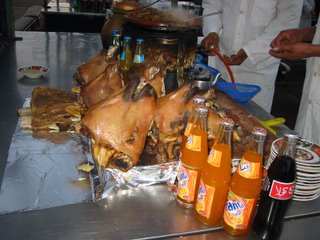The wonderful round tower at Timahoe in County Laois has to be one of the finest in Ireland. The Round Tower stands on the site of a monastery, said to have been founded by Saint Mochua in the seventh century AD.
 |
| Sculpture of St.Mochua's Desk, with his rooster, mouse and fly. Created in by Michael Burke with the staff and students of Scoil Mhuire Fatima in 2004. |
St. Mochua was a seventh century warrior who converted to christianity and became a hermit, he had no worldly possessions at all apart from his psalter, a rooster, a mouse and a fly. The Rooster kept the hour of matins for him so he never missed prayers, the mouse made sure he never slept more than three hours a night by licking his ears if he fell asleep while praying, and the fly would mark his position in the psalter so he never lost his place. The dwelling where St. Mochua lived – Teách Mochua – gives its name to Timahoe.
 The site is most famous for the wonderful round tower that is thought to date from the early part of the twelfth century. It has the most ornate, romanesque-style doorway of any round tower in Ireland, and in the right light conditions you can make out wonderfully intricate carvings of interlacing chevrons and representations of human heads. This doorway is positioned approximately 5m up from the ground level, with the tower itself standing almost 30m tall. For centuries scholars debated about what exactly these iconic Irish round towers were actually used for, with ideas ranging from them serving as look out points or refuges in case of Viking raids. However it is likely that round towers were primarily bell towers, even their name in Irish 'Cloig Teach' translates to 'bell house'. The towers would have also been highly visible markers in the landscape, serving almost as a lighthouse to weary pilgrims who would know that a Round Tower meant a monastic site, where they can buy accommodation and warm food for the night.
The site is most famous for the wonderful round tower that is thought to date from the early part of the twelfth century. It has the most ornate, romanesque-style doorway of any round tower in Ireland, and in the right light conditions you can make out wonderfully intricate carvings of interlacing chevrons and representations of human heads. This doorway is positioned approximately 5m up from the ground level, with the tower itself standing almost 30m tall. For centuries scholars debated about what exactly these iconic Irish round towers were actually used for, with ideas ranging from them serving as look out points or refuges in case of Viking raids. However it is likely that round towers were primarily bell towers, even their name in Irish 'Cloig Teach' translates to 'bell house'. The towers would have also been highly visible markers in the landscape, serving almost as a lighthouse to weary pilgrims who would know that a Round Tower meant a monastic site, where they can buy accommodation and warm food for the night.You can also discover the remains of a fifteenth century Franciscan Friary church. After the Dissolution of the Monasteries in the 1540's, the church and friary were converted into a defensive castle, though little of that survives today. The nineteenth century church next to the round tower is now used as a library.
Timahoe is a wonderfully peaceful site to visit and is very easy to access. You'll find it about 10km south from Portlaoise on the R426 heading towards Carlow. If you're visiting Timahoe why not try the amazing Rock of Dunamase that is located close by to the north. We have a free audioguide available that will lead you around this magnificent site and tells you the story of its bloody and tempestuous history. You can download the guide for free from www.abartaaudioguides.com and it is now available as a great free audio-visual app for iPhone. Simply download the free Guidigo app and access Dunamase from there.
I hope you enjoy this blog, we're trying to cover as many sites as we can across Ireland. If anyone has any suggestions about sites you'd like us to cover please do leave us a comment. If you enjoy information and images of Irish heritage sites then do follow us on Facebook, Twitter and Google+
All photographs © Neil Jackman / abartaaudioguides.com





































